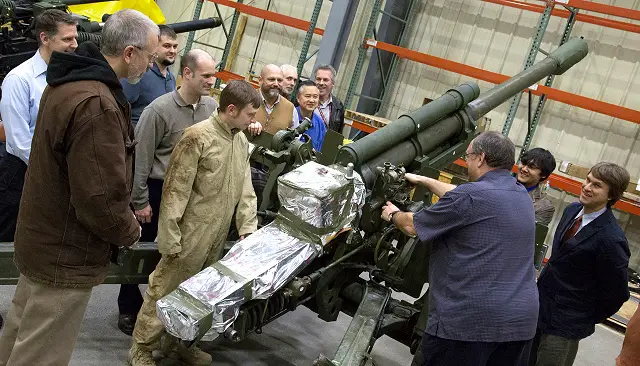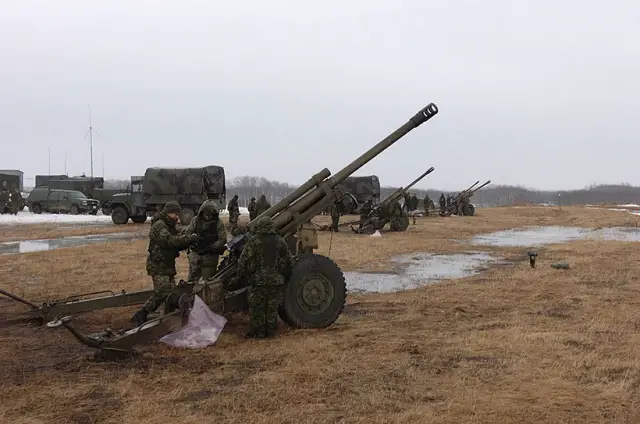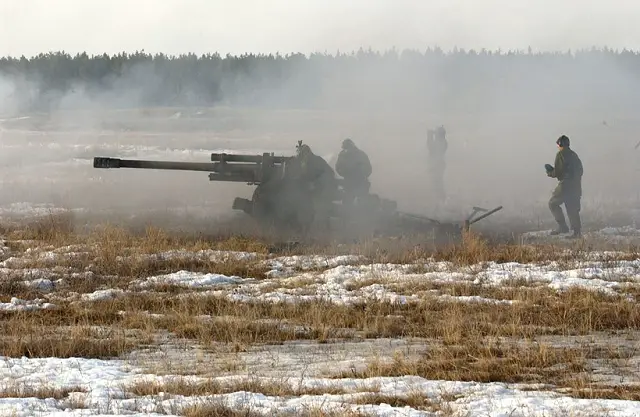| a | |||
U.S. to upgrade Canadian howitzer |
|||
| Wednesday, January 29, 2014 10:16 AM | |||
| United States Picatinny engineers to upgrade C3 105mm towed howitzer of Canadian army. | |||
The
Canadian Royal Army has enlisted the help of United States Picatinny engineers
to evaluate the life-span of their World War II-era C3 105mm towed howitzer.
"We are looking for engineering data that, unfortunately, we're missing
right now," said Canadian Army Maj. David Lebel, Equipment Management
team leader for Field Artillery Systems. |
|||
| |
|||
 Kenneth Whitnall, Canadian Army Life Cycle material manager for 105 mm Howitzer Fleets, explains to members of the Armament Research, Development and Engineering Center how to conduct maintenance on the C3 Howitzer. |
|||
| The C3 Howitzer is a 1950's technology that the Canadian Army is trying to keep in service for ten or 11 more years. "The fleet is now about 60 years old, and after it was modified to fit Canadian needs, we didn't think at that time to have the contractor provide engineering data -- to check the rail forces or validate the forces that are applied to the structure, either while it's firing or while it's being towed," Lebel explained. "Now that it's been around for 60 years, we're starting to experience a few cracks here and there, but we can't explain how these cracks are being made. We need to be able to find solutions without having to ground the fleet for a long amount of time." The Canadian Army uses the C3 howitzers for training, although they use the 155 mm M777 in combat. The operation procedures for towed howitzers are similar, but 105 mm ammunition is cheaper than 155 mm ammunition. "We take a lot of time to train before going into operations, so this reduces cost," Lebel said. |
|||
 The C3 Howitzer has the capability to fire extended range munitions up to 18 kilometres. |
|||
Picatinny's
Program Executive Office Ammunition, known as PEO Ammo, employees, with
help from Armament Research, Development and Engineering Center, or ARDEC,
engineers, is conducting an analysis of the stresses of the C3 Howitzer
in order to support the howitzer's life cycle, said Luke Helsel, ARDEC's
C3 Evaluation team lead.
The team will conduct a series of tests over the next year to determine potential problems that could occur throughout the system. "We're going to do analysis to help the Canadian Army find those problems in advance," said Helsel. "It helps them better predict areas to target for inspections or to perform upgrades. Sometimes that can be a challenge when looking at a design that was done years ago, and has no support from the original contractor." The data packages for the howitzer are from the 1940s, and they have been updated through the 1980s, but there's no subject matter expert to refer to for questions. "It's fascinating to look at the older style of design, and to see what we can do to support them maintain their fleet for the next couple of years," said Helsel. "Some of these slick things they did back then are good to look at now. The old design can inspire us for modern work and working on this project we can discover new analysis techniques that we can use here for the M119 or M777." A gun was recently shipped to Aberdeen Proving Ground, Md., for mobility trials. In April, it will be transferred to Yuma Proving Ground, Ariz., for firing trials. At Aberdeen, engineers will instrument the gun with strain gauges to measure the amount the metal is being pulled while towing the gun. The gun will also be towed around a series of courses over hills and other terrain while recording data from the gauges. "Then, using that data, we can predict virtually what the strain is throughout the whole carriage," said Hesel. "After that, we can come back and figure out where we think the other high strain areas are and perform another test to confirm our analysis." At Yuma, engineers will do similar testing while firing the howitzers at different elevations and azimuths. "This will give us the engineering technical argument to pursue the direction we need to," Lebel said. "Hopefully, we'll be able to find a few simple, small fixes to extend the lifecycle without having to re-engineering big assemblies on the gun." The Canadian Army currently has almost 100 deployed across Canada, and the process for replacing the howitzers with newer models could take up to two decades. |
|||
 The C3 is structurally similar to the C1 Howitzer, but is distinguished by its longer 33-calibre barrel and muzzle brake. The gun can fire all standard NATO 105-mm Howitzer ammunition. |
|||
The
C3 Howitzer is a close support, field artillery weapon that is mobile,
general purpose, light towed, and has the capability to fire extended
range munitions up to 18 kilometres.
The C3 is manually operated, single-loaded and air-cooled. It uses semi-fixed ammunition and consists of the cannon assembly, the carriage and the recoil mechanism. It can easily be employed for direct or indirect fire and can be elevated to high angles to reach targets hidden from flat trajectory guns. |
|||
United States Picatinny engineers to upgrade C3 105mm towed howitzer of Canadian army 2901142
- Posted On














